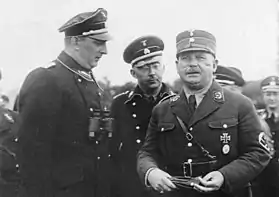Michael Lippert
Michael Lippert (24 April 1897 – 1 September 1969) was a mid-level commander in the Waffen-SS of Nazi Germany during World War II. He commanded several concentration camps, including Sachsenhausen, before becoming a commander of the SS-Freiwilligen Legion Flandern and the SS Division Frundsberg. He is known for co-murdering SA leader Ernst Röhm on 1 July 1934. In 1957, he was sentenced to 18 months in prison by a West German court for his part in Röhm's murder.
Michael Lippert | |
|---|---|
| Born | 24 April 1897 Schönwald, Bavaria |
| Died | 1 September 1969 (aged 72) |
| Allegiance | |
| Service/ | |
| Rank | Standartenführer |
| Commands held | SS-Freiwilligen Legion Flandern SS Division Frundsberg |
| Battles/wars | World War II |
Career in the SS
Lippert joined the Nazi Party (number - 246,989) In June 1930 and the SS (number - 2,968) in March 1931. He became the adjutant for Theodor Eicke, who was appointed the commandant of Dachau concentration camp in 1933.[1][2]
Execution of Ernst Röhm

In early 1934, Hitler and other Nazi leaders became concerned that Ernst Röhm, chief of the SA, was planning a coup d'état.[3] Hitler decided on 21 June that Röhm and the SA leadership had to be eliminated. The purge of the SA leadership and other enemies of the state began on 30 June in an action which became known as the Night of the Long Knives. Eicke, along with hand-chosen members of the SS and Gestapo, assisted Sepp Dietrich's Leibstandarte SS Adolf Hitler in the arrest and imprisonment of SA commanders, before they were shot.[4][5] After Röhm was arrested, Hitler gave the order that the imprisoned Röhm was to be executed. Himmler communicated Hitler's order to Eicke.[6] Eicke was told to first give Röhm the choice to commit suicide. Accompanied by Lippert, and SS-Gruppenführer Ernst-Heinrich Schmauser, Eicke travelled to Stadelheim Prison in Munich where Röhm was being held.[7]
After telling Röhm that he had forfeited his life and that Hitler had given him a last chance to avoid the consequences, Eicke laid a pistol on a table in Röhm's cell and told him that he had 10 minutes in which to use the weapon to kill himself. Eicke, Lippert and Schmauser left and waited in the corridor for 15 minutes, during which time no shot was heard. Finally, Eicke and Lippert drew their pistols and re-entered Röhm's cell. Both fired and Röhm fell to the floor. One of the two then crossed to Röhm and administered a coup-de-grace.[8][9]
Postwar criminal conviction
In 1956, the Munich authorities began an investigation into the Night of the Long Knives and in August arrested Lippert and Sepp Dietrich for their part in it. They were bailed, and the trial itself did not commence until 6 May 1957. They were represented by the lawyer Alfred Seidl who had defended Rudolf Hess at the Nuremberg Trials. Lippert and Dietrich were charged with manslaughter, in Lippert's case for the death of Röhm. Lippert asserted that he had remained outside Röhm's cell, and only Theodor Eicke had gone in. On 10 May, the case was summed-up and the prosecutor demanded a two-year sentence for Lippert. On 14 May, the President of the Court found both Lippert and Dietrich guilty and sentenced both men to 18 months. He described Lippert as "filled with a dangerous and unrepentant fanaticism".[10] Lippert died on 1 September 1969.
Summary of SS career
- Hauptwachtmeister der Landespolizei - 1920
- SS-Truppführer - 10 March 1931
- SS-Sturmführer - 15 November 1931
- SS-Sturmhauptführer - 5 August 1933
- SS-Sturmbannführer - 9 November 1933
- SS-Obersturmbannführer - 1934[9]
- Oberleutnant der Reserve (Luftwaffe) - 1 December 1939
- SS-Obersturmbannführer der Reserve der Waffen-SS — 4 January 1940
- SS-Standartenführer der Waffen-SS - 20 April 1943
Notes
- Padfield 2001, p. 129.
- Stein 1984, p. 8.
- Kershaw 2008, pp. 306–309.
- Dams & Stolle 2014, pp. 14–15.
- Cook & Bender 1994, pp. 22–24.
- Kershaw 2008, pp. 309–314.
- Miller 2006, p. 291.
- Miller 2006, p. 292.
- Shirer 1960, p. 221.
- Messenger 2005, pp. 204–205.
References
- Cook, Stan; Bender, R. James (1994). Leibstandarte SS Adolf Hitler: Uniforms, Organization, & History. San Jose, CA: R. James Bender. ISBN 978-0-912138-55-8.CS1 maint: ref=harv (link)
- Dams, Carsten; Stolle, Michael (2014). The Gestapo: Power and Terror in the Third Reich. Oxford and New York: Oxford University Press. ISBN 978-0-19-966921-9.CS1 maint: ref=harv (link)
- Kershaw, Ian (2008). Hitler: A Biography. New York: W. W. Norton & Company. ISBN 978-0-393-06757-6.CS1 maint: ref=harv (link)
- Messenger, Charles (2005). Hitler's Gladiator: The Life and Wars of Panzer Army Commander Sepp Dietrich. London. ISBN 978-1-84486-022-7.CS1 maint: ref=harv (link)
- Miller, Michael (2006). Leaders of the SS and German Police, Vol. 1. R. James Bender Publishing. ISBN 9-32970-037-3.CS1 maint: ref=harv (link)
- Padfield, Peter (2001) [1990]. Himmler: Reichsführer-SS. London: Cassel & Co. ISBN 0-304-35839-8.CS1 maint: ref=harv (link)
- Shirer, William L. (1960). The Rise and Fall of the Third Reich. New York: Simon & Schuster. ISBN 0-671-72869-5.CS1 maint: ref=harv (link)
- Stein, George (1984) [1966]. The Waffen-SS: Hitler's Elite Guard at War 1939–1945. Cornell University Press. ISBN 0-8014-9275-0.CS1 maint: ref=harv (link)